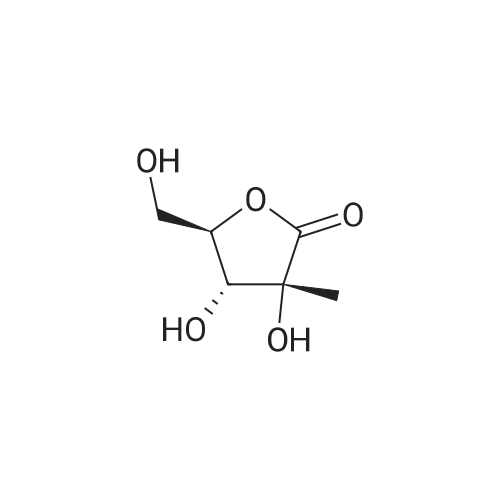|
|
D-Glucose (90.1 g) was suspended in absolute ethanol (130 mL) with acetic acid (30.0 g) and was charged to a reactor at 20 0C. Dimethylamine solution (33percent solution in absolute ethanol, 69.7 g) was added to the suspension within 30 minutes at 20 0C (exothermic), and a dropping funnel employed for additions to the reactor was rinsed with absolute ethanol (5 mL). The reaction mixture was heated to 75 0C. within a 30 minute period, then cooled to 55 0C. within 1 hour, and maintained at 55 0C. for an additional 2 hours, to afford a orange solution. The orange solution then was concentrated at 50 0C. in vacuo to provide a brown oil. Water (190 g) was then added to the brown oil, and the reactor was evacuated three times to approximately 100 mbar and each time was relieved with nitrogen, following which a weak nitrogen flow was continued. Calcium oxide (36.5 g) was added in 4 portions at 10 minute intervals at15 0C, with rises of approximately 5 0C. in internal temperature observed after addition of each portion. The reactor was evacuated twice to approximately 100 mbar and relieved with nitrogen, following which a weak nitrogen flow was continued. The mixture then was heated to an internal temperature of 25 0C within about 20 minutes, then heated to an internal temperature of 40 0C. within 18 hours, following which it was stirred at an internal temperature of 40 0C for four hours, and finally cooled to an internal temperature of 3 0C. 96percent sulfuric acid (80.6 g) was added over a 2 hour period while maintaining an internal temperature of 3 0C to provide a yellow colored mixture. The pH was checked to reach a targeted pH of between 2.4 and 2.7; EPO <DP n="29"/>if the pH was >2.7, sulfuric acid was added to reach the target value. The yellow mixture next was heated to an internal temperature of 45 0C within 30 minutes, stirred for 12 hours while maintaining the 45 0C internal temperature, and then cooled to 25 0C. Calcium sulfate that formed was removed by filtration through a scintered glass funnel into a 2 L. filter flask, and the filtration residue was washed via the reactor in three portions of water (100 g per portion) to provide a brown filtrate. This filtrate was concentrated at a temperature of 50 0C and pressure of 40 mbar by use of a rotary film evaporator, and then was degassed at 50 0C and 20 ~^ 10 mbar for 1 hour. Next, acetone (500 mL), water (50 g) and Fuller's earth (50 g) were added to the concentrated filtrate, and this mixture was refluxed for 30 minutes, after which the upper liquid phase was decanted and filtered through a cellflock pad. The lower phase was extracted twice with acetone (250 mL) and water (25 g) under reflux for 5 minutes. The upper liquid phase was decanted and filtered through a cellflock pad for each of the two extractions. Next, the combined filtrates were concentrated at a temperature of 50 0C and 450 mbar by using a rotary film evaporator, and the degassed at 50 0C and 20 -^ 10 mbar for 1 hour to provide 60.8 g of crude product as a dark brown solid. Acetone (90 mL) was added to the crude product at a temperature of 60 0C. over a 10 minute time period, and the mixture was stirred at 60 0C, then at an internal temperature of 50-56 0C for 5-15 minutes to afford a suspension in a volume of 200 mL. Next, the mixture containing the suspension was cooled to an internal temperature of 20 0C, and the contents were stirred for 2 hours while maintaining the internal temperature at 20 0C. The mixture then was filtered through a scintered glass funnel (porosity 3), and the filter cake washed twice with acetone (15 mL) at room temperature to provide the final product. The final product was dried in vacuum at 50 0C for 5 hours to afford 28.7 g of 2-C-Methyl-D-ribono-l,4-lactone as a yellow-white solid. EPO <DP n="30"/> |
|
|
D-Glucose (3.17 g, 17.6 mmol) was suspended in ethanol (5 niL) with glacial acetic acid (1 niL). Dimethylamine solution (33percent solution in methylated spirits, 3.2 mL, 18.0 mmol) was added to the suspension and the reaction mixture stirred at 80 0C for one and a half hours. The resulting dark orange solution was concentrated in vacuo to afford a crude dark orange-brown oil (6.55 g). The crude product mixture was then dissolved in water (150 mL) and stirred at 70 0C with calcium oxide (5.6fg, 100 mmol) for 24 hours when TLC analysis (chloroform:methanol:water:acetic acid, 60:30:5:3) revealed no starting materials (Rf 0.09 0.24) and only baseline products. LRMS analysis (ESI -ve) of the crude alkaline reaction mixture showed only one major peak at 179.01 Da. Oxalic acid dihydrate (6.74 g, 53.5 mmol) was added to the suspension to afford a pale pink precipitate suspended in a solution with a measured pH of 10. The mixture was allowed to cool to room temperature, filtered through a pad of Celite.(R). with water and the filtrate passed through Amberlite.(R). IR 120 ion exchange resin, using water as eluent. The water was then removed under reduced pressure to afford a crude orange oil (2.39 g). The crude product was dissolved in water (50 mL) and heated at 40 0C for 15 minutes. TLC analysis (15percent methanol in dichloromethane) revealed the presence of one major product (Rf 0.38) and LRMS analysis (ESI -ve) revealed no peak at 179.01 Da and a major peak at 161.15 Da. The water was removed under reduced pressure and the crude product purified by flash column chromatography (ethyl acetate: cyclohexane, (1:1) --> ethyl acetate) and subsequently by recrystallisation from ethyl acetate by the addition of cyclohexane to afford 2-C-methyl-D-ribono-l,4-lactone (534 mg, 19percent) as a white crystalline solid; mp 158-159 0C {Lit. 160-161 0C); [alpha]^5 +87.5 (c 0.76 in water) {Lit. [alpha.pound.° +93 (water)}; vmax(film): 3356 (br, O-H), 1773 (gamma-lactone C=O) cm4; deltaH (CD3OD, 400 EPO <DP n="31"/>MHz): 1.40 (3H, CH3), 3.71 (IH, dd, J4)5 4.5 Hz, J5,5> 12.8Hz, H-5), 3.90 (IH, d, J3j4 7.8 Hz, H-3), 3.94 (IH, dd, J4,5> 2.4 Hz, J5)5' 12.8 Hz, H-5'), 4.29 (IH, ddd, J4,s 4.5 Hz, J4)5> 2.4 Hz, J3)4 7.8 Hz, H-4); deltac (CD3OD, 100.6 MHz): 20.02 (CH3), 60.03 (C-5), 72.55 (C-2), 72.64 (C-3), 83.43 (C-4), 176.97 (C-I); LRMS m/z (ESI -ve): 161.04 (M-H+, 100percent), 183.00 (M+Na+-2H+, 47percent); HRMS m/z (ESI -ve): found 161.0455 (M-H+); C6H9O5 requires 161.0450. |

 Chemistry
Chemistry
 Pharmaceutical Intermediates
Pharmaceutical Intermediates
 Inhibitors/Agonists
Inhibitors/Agonists
 Material Science
Material Science















 For Research Only
For Research Only
 120K+ Compounds
120K+ Compounds
 Competitive Price
Competitive Price
 1-2 Day Shipping
1-2 Day Shipping













